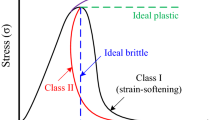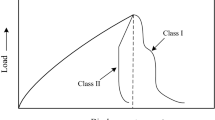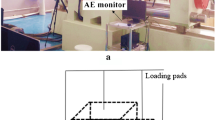Abstract
It is well known from laboratory testing that the rock failure process becomes unstable in a soft test machine due to excessive energy released from the machine. Great efforts had been devoted to increasing the loading system stiffness (LSS) of laboratory test machines to ensure that the post-peak stress–strain curve of rock can be obtained for underground rock engineering design. A comprehensive literature review on the development of stiff test machines reveals that because of the differences in the manufacturing arrangement of the test machines, LSS values of the test machines used for rock property testing are always finite and vary in a large range, and the influence of LSS on stable rock failure is less understood. A FEM-based numerical experiment is carried out to study the influence of LSS on the stress–strain curves of stable rock failure in uniaxial compression, with a focus on the post-peak deformation stage. Three test machine loadings including idealized rigid loading, platen loading, and frame–platen loading with finite LSS are considered, and the simulation results are analyzed and compared. The modeling results obtained from the simulations indicate that even if the LSS value is large enough to inhibit unstable rock failure, as long as LSS is finite, it has an influence on the post-peak stress–strain curve of rock. It is revealed that because the input energy supplied by the external energy source to drive the stable rock failure process is affected by the finite LSS of a test machine, the post-peak descending slopes of the stress–strain curves are all steeper than the post-peak descending slope obtained under an ideal loading condition of infinite LSS. An insight from this numerical experiment is that it might be more feasible to develop laboratory test machines with variable LSS that can match the local mine stiffness in the field for rock property testing.






























Similar content being viewed by others
Notes
Note that the displacement rate applied using an explicit algorithm for solving quasi-static problems is not comparable to that used real rock testing because it is computationally impractical to model the loading process in its physical time when the explicit algorithm is used. Instead, an optimal displacement rate was selected through a parametric study to ensure that the computation is cost-effective by increasing the displacement rate, while it does not cause serious oscillation that normally leads to dynamic loading to the specimen.
Note that no loading components other than the thermal loading platen are defined with the thermal property for heat conduction; thus, there is no heat conduction between the thermal platen and the specimen.
Abbreviations
- A :
-
Cross-sectional area
- δ :
-
Displacement
- E in :
-
Accumulative energy input from an external energy source at peak load
- E t :
-
Energy stored in a test machine at peak load
- E r :
-
Accumulative energy consumed in a rock specimen at peak load
- E *in :
-
Accumulative energy input from an external energy source at the post-peak deformation stage
- E *t :
-
Energy stored in a test machine at the post-peak deformation stage
- E *r :
-
Accumulative energy consumed in a rock specimen at the post-peak deformation stage
- ΔE in :
-
Energy input from an external energy source during post-peak deformation
- ΔE t :
-
Energy released from a test machine during post-peak deformation
- ΔE r :
-
Energy consumed in a rock specimen during post-peak deformation
- ΔE Br :
-
Energy item ΔE r under the ideal loading condition
- E p :
-
Post-peak stiffness of a rock specimen in stress–strain curve
- H :
-
Height
- k :
-
Stiffness of a column-shaped structure
- λ :
-
Post-peak stiffness of a rock specimen
- LSSP :
-
Stiffness of a platen loading test machine
- LSSF :
-
Stiffness of a frame–platen loading test machine
References
ABAQUS (2010) Abaqus 6.10: analysis user’s manual. Dassault Systèmes Simulia Corp, Providence
Alonso E, Alejano L, Varas F, Fdez-Manin G, Carranza-Torres C (2003) Ground response curves for rock masses exhibiting strain-softening behaviour. Int J Numer Anal Meth Geomech 27:1153–1185
Baumgart F (2000) Stiffness—an unknown world of mechanical science? Inj Int J Care Inj 31:14–23
Bieniawski Z (1966) Mechanism of rock fracture in compression. CSIR Report. 459. South African Council for Scientific and Industrial Research
Bieniawski Z (1967a) Mechanism of brittle fracture of rock: part II—experimental studies. Int J Rock Mech Min Sci Geomech Abstr 4:407–423
Bieniawski ZT (1967b) Mechanism of brittle fracture of rock: part I—theory of the fracture process. Int J Rock Mech Min Sci Geomech Abstr 4:395–406
Bieniawski ZT, Denkhaus HG, Vogler UW (1969) Failure of fractured rock. Int J Rock Mech Min Sci Geomech Abstr 6:323–341
Blake W, Hedley DG (2003) Rockbursts: case studies from North American hard-rock mines. Society for Mining, Metallurgy, and Exploration, Englewood
Bobet A (2001) Influence of the loading apparatus on the stresses within biaxial specimens. ASTM Geotech Test J 24:256–272
Bobet A, Einstein H (1998) Fracture coalescence in rock-type materials under uniaxial and biaxial compression. Int J Rock Mech Min Sci 35:863–888
Cai M (2008) Influence of intermediate principal stress on rock fracturing and strength near excavation boundaries—insight from numerical modeling. Int J Rock Mech Min Sci 45:763–772
Cai M, Kaiser P, Tasaka Y, Minami M (2007) Determination of residual strength parameters of jointed rock masses using the GSI system. Int J Rock Mech Min Sci 44:247–265
Chen WF, Han DJ (2007) Plasticity for structural engineers. J. Ross Publishing, Plantation
Cook NGW (1965) The failure of rock. Int J Rock Mech Min Sci 2:389–403
Cook NGW, Hojem JPM (1966) A rigid 50-ton compression and tension testing machine. JS Afr Inst Mech Eng 1:89–92
Cook NGW, Hojem JPM (1971) A 200-ton stiff testing machine. S Afr Mech Eng (in press)
Dai F, Wei M, Xu N, Ma Y, Yang D (2015) Numerical assessment of the progressive rock fracture mechanism of cracked chevron notched Brazilian disc specimens. Rock Mech Rock Eng 48:463–479
Dai F, Li B, Xu N, Meng G, Wu J, Fan Y (2016) Microseismic monitoring of the left bank slope at the Baihetan Hydropower Station. Rock Mech Rock Eng, China. doi:10.1007/s00603-016-1050-9
Fairhurst C, Hudson J (1999) Draft ISRM suggested method for the complete stress–strain curve for intact rock in uniaxial compression. Int J Rock Mech Min Sci 36:279–289
Fakhimi A, Hosseini O, Theodore R (2016) Physical and numerical study of strain burst of mine pillars. Comput Geotech 74:36–44
Gettu R, Mobasher B, Carmona S, Jansen D (1996) Testing of concrete under closed-loop control. Adv Cem Based Mater 3:54–71
Griggs DT (1936) Deformation of rocks under high confining pressures: I. Experiments at room temperature. J Geol 44:541–577
Handin J (1953) An application of high pressure in geophysics: experimental rock deformation. Trans Am Soc Mech Eng 75:315–324
He C, Okubo S, Nishimatsu Y (1990) A study of the class II behaviour of rock. Rock Mech Rock Eng 23:261–273
He M, Miao J, Feng J (2010) Rock burst process of limestone and its acoustic emission characteristics under true-triaxial unloading conditions. Int J Rock Mech Min Sci 47:286–298
Hemami B, Fakhimi A (2014) Numerical simulation of rock–loading machine interaction. In: 48th US rock mechanics/geomechanics symposium, Minneapolis, Minnesota. American Rock Mechanics Association, Minneapolis, pp 14–7488
Hudson JA, Harrison JP (2000) Engineering rock mechanics—an introduction to the principles. Elsevier Science, Amsterdam
Hudson J, Brown E, Fairhurst C (1971) Optimizing the control of rock failure in servo-controlled laboratory tests. Rock Mech 3:217–224
Hudson JA, Crouch SL, Fairhurst C (1972) Soft, stiff and servo-controlled testing machines: a review with reference to rock failure. Eng Geol 6:155–189
Kias E, Ozbay U (2013) Modeling unstable failure of coal pillars in underground mining using the discrete element method. In: 47th US rock mechanics/geomechanics symposium, San Francisco. American Rock Mechanics Association, San Francisco, pp 13–174
Kiendl OG, Maldari T (1938) A comparison of physical properties of concrete made of three varieties of coarse aggregate. University of Wisconsin Thesis for degree of BS in Civil Engineering
Labuz J, Biolzi L (2007) Experiments with rock: remarks on strength and stability issues. Int J Rock Mech Min Sci 44:525–537
Lockner DA (1995) Rock failure. In: Ahrens TJ (ed) Rock physics & phase relations: a handbook of physical constants, vol 3. American Geophysical Union, Washington, pp 127–147
Manouchehrian A, Cai M (2015) Simulation of unstable rock failure under unloading conditions. Can Geotech J 53:22–34
Martin C, Chandler N (1994) The progressive fracture of Lac du Bonnet granite. Int J Rock Mech Min Sci Geomech Abstr 31:643–659
Milev A, Spottiswoode S, Rorke A, Finnie G (2001) Seismic monitoring of a simulated rockburst on a wall of an underground tunnel. J S Afr Inst Min Metall 101:253–260
Mogi K (2007) Experimental rock mechanics. CRC Press, Balkema
Morsy K, Peng S (2002) Evaluation of a mine panel failure using the local mine stiffness criterion—a case study. In: proceeding of transactions 2002, vol 312. Society for Mining, Metallurgy, and Exploration, Inc., pp 8–19
MTS (2013) MTS Model 815 and 816 rock mechanics test systems. User’s manual. MTS Systems Corporation, Eden Prairie
Okubo S, Nishimatsu Y (1985) Uniaxial compression testing using a linear combination of stress and strain as the control variable. Int J Rock Mech Min Sci Geomech Abstr 22:323–330
Paterson MS, Wong T-f (2005) Experimental rock deformation: the brittle field. Springer, Berlin
Peng SS (1973) Time-dependent aspects of rock behavior as measured by a servocontrolled hydraulic testing machine. Int J Rock Mech Min Sci Geomech Abstr 10:235–246
Potyondy D, Cundall P (2004) A bonded-particle model for rock. Int J Rock Mech Min Sci 41:1329–1364
Rist M, Sammonds P, Murrell S (1991) Strain rate control during deformation of ice: an assessment of the performance of a new servo-controlled triaxial testing system. Cold Reg Sci Technol 19:189–200
Rudnicki JW, Rice J (1975) Conditions for the localization of deformation in pressure-sensitive dilatant materials. J Mech Phys Solids 23:371–394
Rummel F, Fairhurst C (1970) Determination of the post-failure behavior of brittle rock using a servo-controlled testing machine. Rock Mech 2:189–204
Salamon MDG (1970) Stability, instability and design of pillar workings. Int J Rock Mech Min Sci Geomech Abstr 7:613–631
Schulson E (1999) The structure and mechanical behavior of ice. J Miner Met Mater Soc 51:21–27
Shepherd J, Rixon L, Griffiths L (1981) Outbursts and geological structures in coal mines: a review. Int J Rock Mech Min Sci Geomech Abstr 18:267–283
Sinha NK, Frederking RMW (1979) Effect of test system stiffness on strength of ice. No. 873, Division of Building Research
Smith D (1980) David Kirkaldy (1820–1897) and engineering materials testing. Trans Newcomen Soc 52:49–65
Snowdon R, Ryley M, Temporal J, Crabb G (1983) The effect of hydraulic stiffness on tunnel boring machine performance. Int J Rock Mech Min Sci Geomech Abstr 5:203–214
Späth W (1935) Einfluß der Federung der Zerreißmaschine auf das Spannungs–Drehungs–Schaubild. Verlag Stahleisen, Düsseldorf
Stavrogin AN, Tarasov BG (2001) Experimental physics and rock mechanics. CRC Press, Balkema
Tang C, Tham L, Lee P, Tsui Y, Liu H (2000) Numerical studies of the influence of microstructure on rock failure in uniaxial compression—part II: constraint, slenderness and size effect. Int J Rock Mech Min Sci 37:571–583
Tarasov B, Potvin Y (2013) Universal criteria for rock brittleness estimation under triaxial compression. Int J Rock Mech Min Sci 59:57–69
Ulusay R (2012) The present and future of rock testing: highlighting the ISRM suggested methods. In: ISRM regional symposium—7th Asian rock mechanics symposium, Seoul. International Society for Rock Mechanics, pp 1–22
Van Mier J, Shah S, Arnaud M, Balayssac J, Bascoul A, Choi S, Dasenbrock D, Ferrara G, French C, Gobbi M (1997) Strain-softening of concrete in uniaxial compression. Mater Struct 30:195–209
Vardoulakis I, Labuz JF, Papamichos E, Tronvoll J (1998) Continuum fracture mechanics of uniaxial compression on brittle materials. Int J Solids Struct 35:4313–4335
Wawersik WR (1968) Detailed analysis of rock failure in laboratory compression tests. Ph.D. thesis of University of Minnesota
Wawersik WR, Fairhurst CH (1970) A study of brittle rock fracture in laboratory compression experiments. Int J Rock Mech Min Sci Geomech Abstr 7:561–575
Whitney C (1943) Discussion on VP Jensen’s paper. ACI Mater J 39:584
Xu Y, Cai M (2015) Numerical simulation of end constraint effect on post-peak behaviors of rocks in uniaxial compression. In: 49th US Rock Mechanics/Geomechanics Symposium, San Francisco. International Society for Rock Mechanics, pp 15–510
Xu Y, Cai M (2017) Numerical study on the influence of cross-sectional shape on strength and deformation behaviors of rocks under uniaxial compression. Comput Geotech 84:129–137
Zhang C, Feng X-T, Zhou H, Qiu S, Wu W (2012) Case histories of four extremely intense rockbursts in deep tunnels. Rock Mech Rock Eng 45:275–288
Zhao X, Cai M, Wang J, Ma L (2013) Damage stress and acoustic emission characteristics of the Beishan granite. Int J Rock Mech Min Sci 64:258–269
Zhao X, Cai M, Wang J, Li P (2015) Strength comparison between cylindrical and prism specimens of Beishan granite under uniaxial compression. Int J Rock Mech Min Sci 76:10–17
Zipf RK Jr (1992) Analysis of stable and unstable pillar failure using a local mine stiffness method. In: Proceedings of the workshop on coal pillar mechanics and design, Washington, DC. U. S. Bureau of Mines, pp 128–143
Acknowledgements
This work was financially supported by NSERC (Natural Science and Engineering Research Council of Canada, Grant No. 249620-2011) and the Open Research Fund of the State Key Laboratory of Geomechanics and Geotechnical Engineering, Institute of Rock and Soil Mechanics, Chinese Academy of Sciences (Grant No. Z015001).
Author information
Authors and Affiliations
Corresponding author
Rights and permissions
About this article
Cite this article
Xu, Y.H., Cai, M. Influence of Loading System Stiffness on Post-peak Stress–Strain Curve of Stable Rock Failures. Rock Mech Rock Eng 50, 2255–2275 (2017). https://doi.org/10.1007/s00603-017-1231-1
Received:
Accepted:
Published:
Issue Date:
DOI: https://doi.org/10.1007/s00603-017-1231-1




